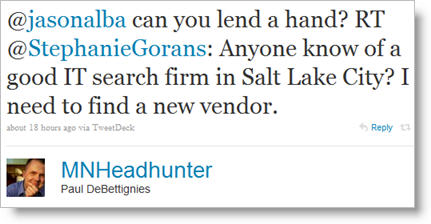On my JibberJobber user webinar I share a lot of job search, networking, branding and other career management ideas I’ve picked up along the way.
One of my most favorite mini-ideas is this:
You don’t find job leads from your first and second degree contacts. You find them from your third and fourth degree contacts.
Same with sales leads…. this is the part about networking that can be hard… always asking “do you know someone that _________?” It could be someone from a certain company, or industry, or that meets a certain profile.
The frustrating thing was keeping track of the breadth and the depth of your network… if I’m networking a lot, HOW do I keep track of all of the third and fourth degree contacts? Or, the SEVENTH degree contacts??
You can easily do this in JibberJobber (here’s a post I need to update about how this works in JibberJobber).
Anyway, I had an experience two days ago that helped drive this mini-idea home.
Here’s what this looks like… the number behind the name is the Degree of Separation TO Stephanie (not to me).
Stephanie asks Paul (1) for help. Paul doesn’t know but he asks me (2). I don’t know the right answer but I referred him to Robert Merrill (3), who knows everyone in this space.
Robert will probably give Stephanie a number of names that he recommends, which will all be 4th degree contacts to Stephanie. She might need to drill down more to a deeper level, but she is getting close just because she asked Paul.
If you aren’t asking “who do you know” of your network, you are missing out on really getting to the right person… you have to drill down.


It’s like a “6 degrees of separation” scenario. LinkedIn really puts it in perspective for you. Just one degree away from my 75 first-hand connections put me at 10,400+ “friends of friends”. Chances are, one of your connections will be able to put you in contact with one of theirs to help you with whatever you’re looking to accomplish.
Actually, LinkedIn doesn’t put it into perspective very well. It does so artificially, but it can produce some bad data.
One example: Let’s say you are my 4th degree contact. We strike up a relationship, connect on LinkedIn, and now we are 1st degree contacts. That is inaccurate information, and anyone you are connected with (my 5th degree contacts) will show as 2nd degree contacts.
Not to completely disassemble your comment, but I don’t see my nth degree contacts as friends of friends (maybe acquaintances of acquaintances?), and based on past tests, I am not even 50% convinced that any of my connections “will be able to put [me] in contact with one of theirs” to help with “whatever [I’m] looking to accomplish.”
The idea is there but to get it to work it takes more than the technology…
Jason, that example certainly drives your point home. I see that it does take more than the technology. The site facilitates asking “who do you know” in a way that has a much broader reach than the pre-social networking days, but you need to keep at it and call upon some good timing to help you find new opportunities.